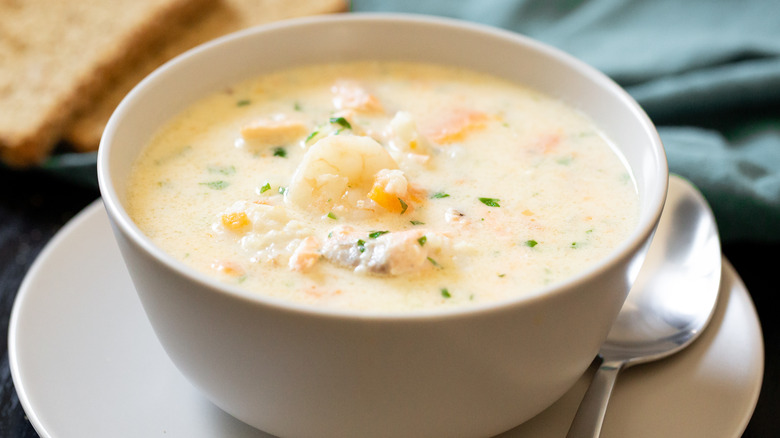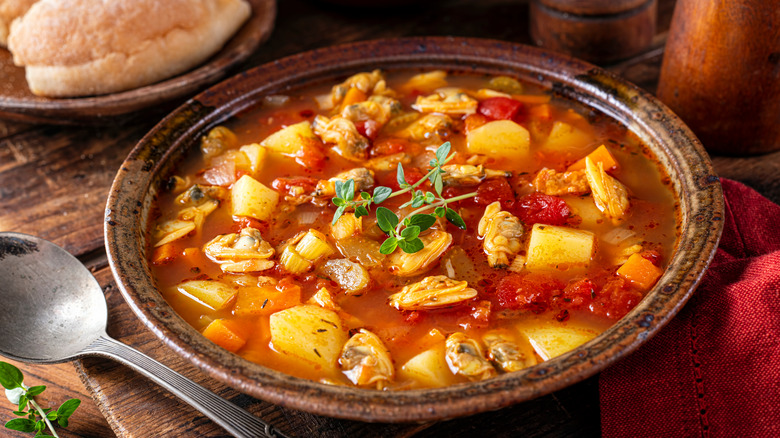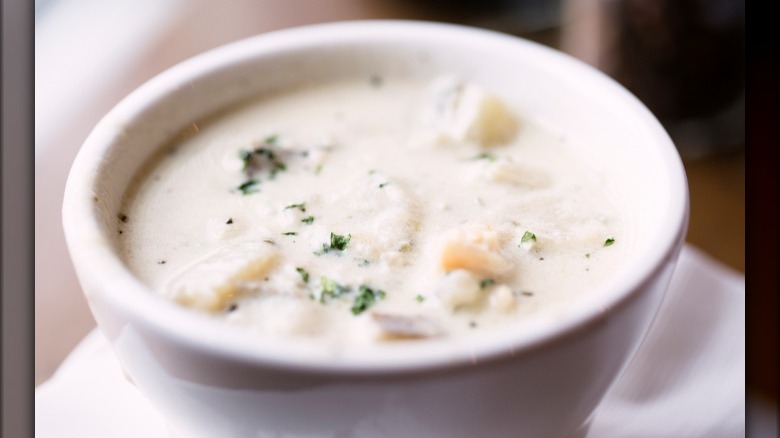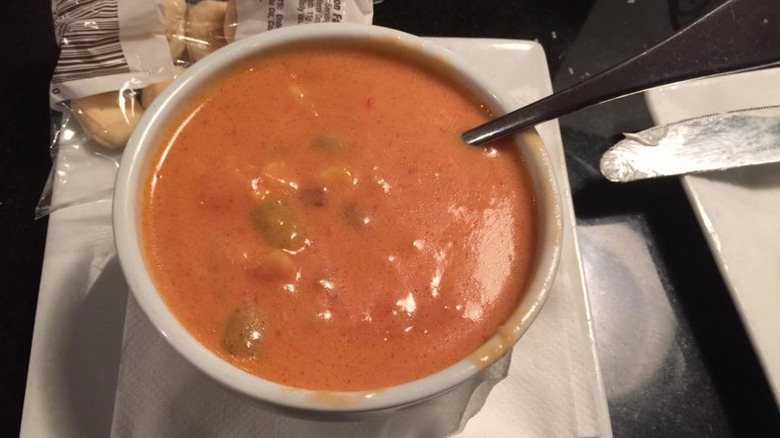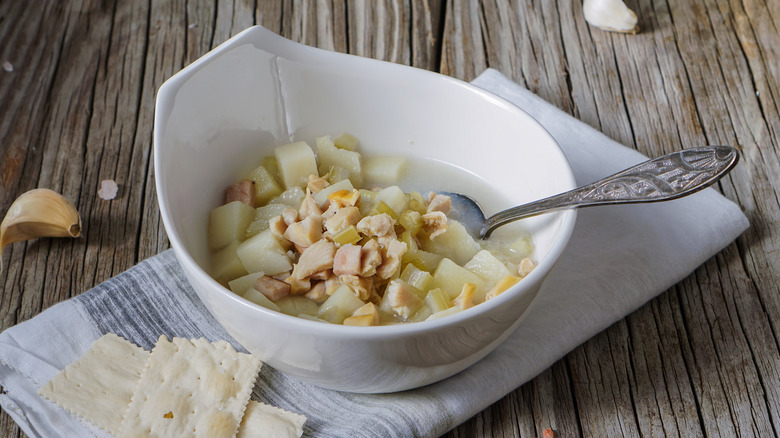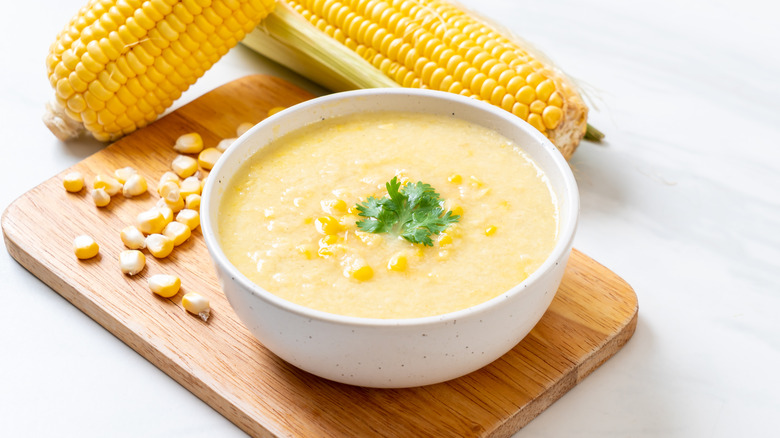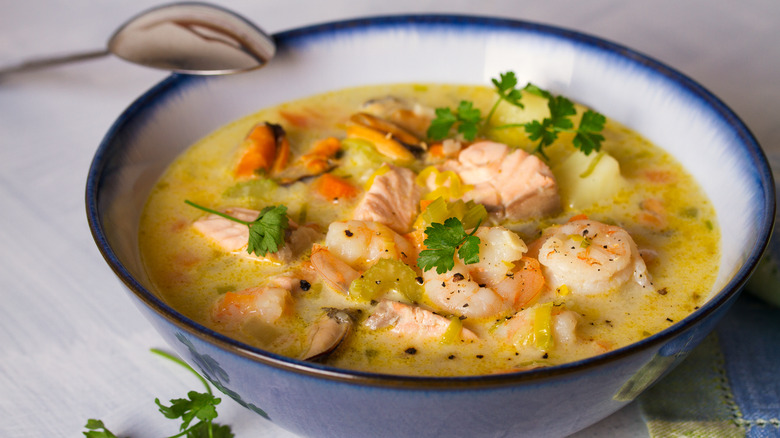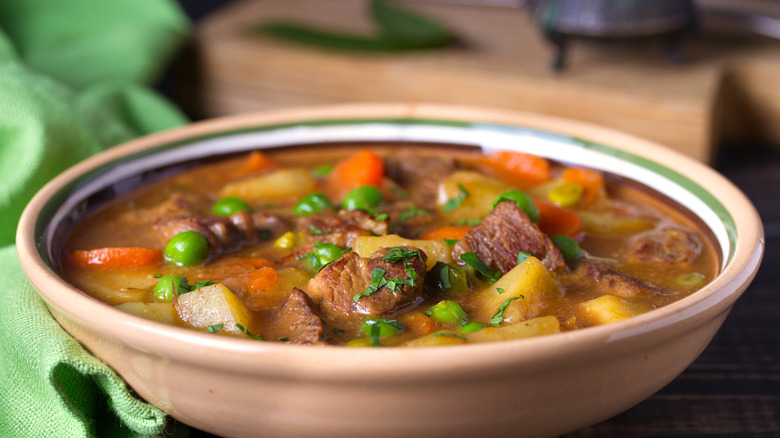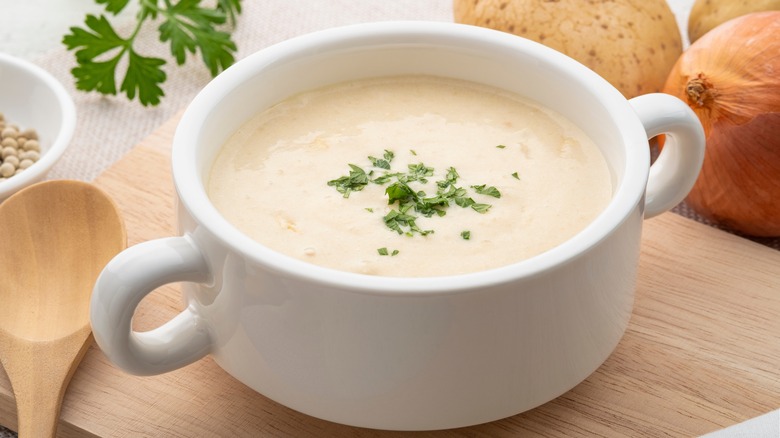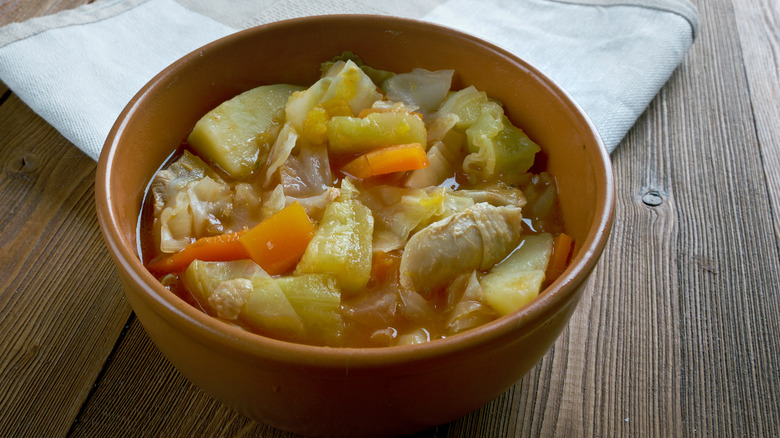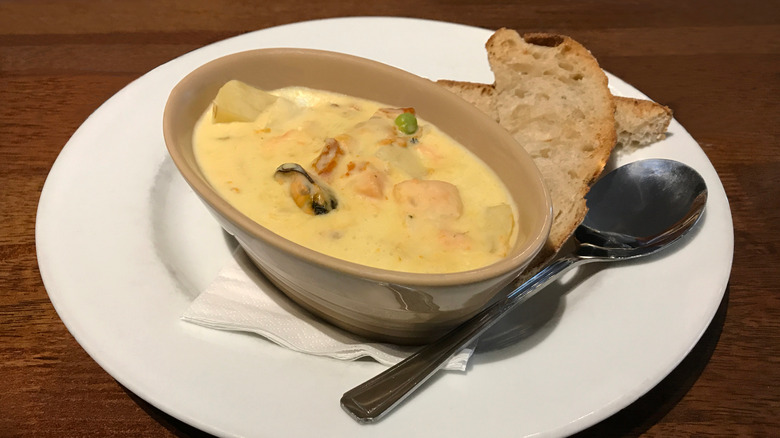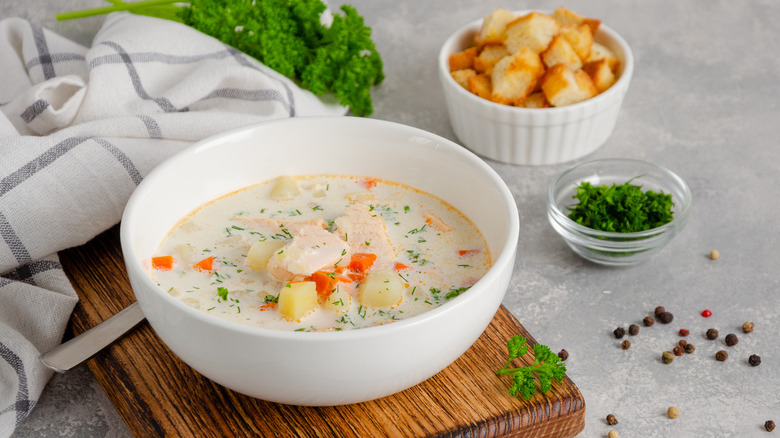The Ultimate Guide To Different Types Of Chowder
Whether you look forward to it as a go-to appetizer every time you step foot in a seafood restaurant or you've just happened to notice how often restaurants offer it on Fridays, chowder has been a staple at many dining establishments all over the world for many, many years. You might think of it as a fairly modern dish, but in fact, its history goes back much further than your local seafood shack. This dish has a heritage that can be traced back to the early 1800s. The word chowder even predates that era: It's based on the French word chaudière, which means cauldron — the vessel in which the earliest chowders were likely made. The use of such an archaic instrument hints at how old this delicious meal truly is.
When we think about chowder, most of us immediately think of thick and creamy New England clam chowder. Some might also think of its redder cousin, Manhattan clam chowder. But the world of chowder is much more vast than those two dishes. It can include virtually any kind of ingredient, if the chef puts their mind to it — and we mean any. Traditionally, chowder is indeed considered to be a seafood dish. But if you cast your gaze far enough, you can find examples of chowders containing other kinds of meat, as well as vegetarian varieties with no meat at all. Get ready to take some notes, because your perception of this beloved dish is about to expand. This is the ultimate guide to different kinds of chowder.
Manhattan clam chowder
Some kinds of chowder aren't distinguishable from each other until you take a bite and find out what ingredients are included or what the texture is like. Other chowders, in contrast, are immediately recognizable by looks alone. Consider Manhattan clam chowder. This bold, sunset-colored dish makes its mark the moment you see it. Its bright red color comes from its tomato-based broth, which you won't find in its New England or Rhode Island cousins. How did this arresting take on the classic soup come to incorporate such a unique ingredient?
As it turns out, the Manhattan variety of clam chowder came about in the late 1800s, when Italian and Portuguese immigrants came to New York City. They sought to include tomatoes, a culinary staple in their cultures, in their seafood stews. The chowder that was born from this desire was an instant hit for some, but not everyone was an ardent fan. Maine representative Cleveland Sleeper once tried to introduce a bill — that's right, an honest to goodness bill — that would have banned tomatoes from being used as an ingredient in clam chowder. This might have come out of fierce loyalty to New England clam chowder, which contains no tomatoes whatsoever. It might have come from an intense aversion to the red fruit. Regardless, Manhattan clam chowder remains a seafood mainstay at many restaurants, so Representative Sleeper's argument clearly had no legs.
New England clam chowder
New England clam chowder is probably the most popular and widely-recognized version of the classic dish. More often than not, if you sit down at a restaurant and see clam chowder on the menu, it's talking about this variety. This complex soup has a distinctively American history, dating as far back as the 19th century. Though its roots are, obviously, in New England, you can find it in dining establishments across the United States, from simple seafood shacks to high-end restaurants. Native New Englanders still claim that the best chowders in the country are right in their own backyard, however — and they're probably not wrong, as even brief visitors to this region can attest. Maine, Vermont, Massachusetts, New Hampshire, Rhode Island, and Connecticut all know how to make a mean clam chowder.
So, how do you know you're eating a New England clam chowder, as opposed to other varieties? The simplest way to tell is by considering the thickness of the broth. New England clam chowder is usually thick and creamy, unlike thinner, more watery varieties, like that of Rhode Island. New England Clam Chowder also universally comes with clams and potatoes mixed into its creamy base, though you may spot other ingredients from time to time, including bacon bits and celery ribs. Whatever you do, do not forget to use the packet of oyster crackers offered on the side. They bring a nice crunch to an otherwise soft and creamy soup.
Long Island clam chowder
If you're from the northeastern United States, then you're probably most familiar with New England, Rhode Island, and Manhattan clam chowders. Each offers a different flavor and texture profile, and can be customized with any number of added ingredients. This gives you all kinds of choices when it comes to making your own chowder at home. But believe it or not, there is a fourth kind of chowder that makes a reference to another region of the northeastern United States: the Long Island clam chowder.
Don't be mistaken in thinking that the Long Island variety incorporates some sort of complicated string of ingredients far different than any other kind of chowder. On the contrary, Long Island clam chowder is essentially the love child of the New England and Manhattan varieties, both in its ingredients and in its name. It's most distinguished by its creamy tomato broth. This may seem like sacrilege to some, but it's gained traction over the years, especially in its home region. As the name suggests, the origins of Long Island clam chowder lie in Long Island, where the best versions are still made. Those looking for the potent tang of tomatoes without sacrificing the richness of cream should seek it out ASAP.
Rhode Island clam chowder
One of the more popular chowder varieties is Rhode Island clam chowder. It is, as you might expect, nearly identical to the New England variety in terms of ingredients. There's really only one major difference, but it's a big one: While New England clam chowder is thick and creamy, Rhode Island clam chowder is thinner and significantly more watery. Here, you won't find generous usage of heavy cream or milk — although, depending on where you order this particular kind of chowder, you may enjoy a splash or two of cream added to the broth just prior to serving. If so, it's a tiny bit harder to distinguish Rhode Island clam chowder from New England clam chowder. But once you've had a few spoonfuls, you'll be able to tell — a single glug of cream isn't the same as a whole helping.
Just like its New England cousin, Rhode Island clam chowder uses potatoes, celery, bacon, and, of course, clams. Its origin is said to date back even earlier than that of New England or Manhattan chowders: This delicious dish was being made before the 1880s. Today, you will primarily find Rhode Island clam chowder in its namesake state, along with neighboring Connecticut, where it may sometimes appear on menus as Noank chowder.
Corn chowder
Many of the most famous chowders use different kinds of seafood as their protein of choice. But even though fish, clams, and shrimp dominate these attention-grabbing variations, don't go thinking you have to use them to make a proper chowder. One of the clearest examples of this is corn chowder. Though this dish can include all kinds of ingredients, none of them are seafood. You might find chicken or bacon in a corn chowder, or you might not find any animal proteins at all, as the name implies. Either way, you can be sure of something: There will be corn, and it will be delicious. Those interested in vegetarian or vegan stews should pay close attention to this toothsome dish.
Like many other corn-derived dishes, corn chowder became prominent in regions where the crop is plentiful, particularly during the harvest seasons. Over time, cooks started to develop new ways of creating this dish, incorporating their own special ingredients and techniques. Today, as a result, there are many different versions of corn chowder. All of them are delicious, though cooks should be careful to use the freshest ingredients possible. There really are no shortcuts here, in that sense, especially when it comes to the corn itself. As a result, corn chowder is an excellent summertime dish.
Seafood chowder
Many of the most popular chowders feature clams as the primary protein. However, not all marine-centric chowders require that particular ingredient. Seafood chowder, for example, can use any combination of ocean critters, from shrimp to codfish to smoked fish. Consider Irish seafood chowder. It's typically lighter than a traditional New England clam chowder, though it still has a creamier base than, say, Rhode Island clam chowder. Keep in mind, though, that you may also run into seafood chowders that are simply clam chowders under another name. Think of it like squares and rectangles: All clam chowders are seafood chowders, but not every seafood chowder is a clam chowder.
Seafood chowder dates back to the early 1800s, like many of the other chowders mentioned on this list. The earliest signs of this chowder can be found in two European regions: Brittany, France and Cornwall, England. Like most other chowders, it has been widely adopted in American culture, where many different variations have come into existence. Depending on who you ask, all of the traditional clam chowders fall under the category of seafood chowder. What truly differentiates the two kinds of chowders is the presence of other kinds of seafood, like fish or shrimp.
Lamb or veal chowder
Are you in search of a heartier bowl of chowder than what's typically offered? Curious about the dish, but not really into seafood? Then you should look no further than the delicious world of lamb and veal chowders. As you might expect, these dishes — which also qualify as stew — swap out the traditional clams and other seafood comestibles for the titular lamb or veal. Similar stews have been around for hundreds of years, and are believed to go back as far as the 1300s. It probably took a few centuries for seafood to be incorporated (and the precise method of cooking in a cauldron to come about), which means lamb and veal chowders are far older than conventional seafood chowders. The stews that gave rise to them were definitely different, but they absolutely count as ancestors to these rich chowders.
Lamb or veal chowders are relatively simple dishes to make. There are no overtly complicated techniques required to create them, so they're great introductory meals for the chowder-curious. What matters most is bringing out the delectable flavors of the meat and letting them shine. Mild vegetables like carrots, potatoes, and peas are traditional ingredients, which allow the lamb or veal to take center stage.
Potato chowder
Looking for a thick, veggie-forward version of chowder? Look no further than the scrumptious potato chowder. This chowder can be one of the thickest around — some think the ideal potato chowder should even be possible to consume with a fork. If you're not into that, though, it can be adjusted. This comfort food is actually hugely versatile in terms of ingredients, which means a lot of potential crossover with other kinds of chowder. You can add meat, corn, herbs, and whatever kind of seasoning you like — the sky is pretty much the limit when it comes to potato chowder.
Now, potatoes are a main ingredient in traditional New England and Rhode Island clam chowders. But they're supporting players there. Here, the tubers are the star — and luckily, this dish is pretty easy to make. Essentially, if you just take the clams out of clam chowder, you're left with the simplest possible potato chowder. From there, you can add corn to make a hybrid corn and potato chowder. You might also add lamb to make a lamb and potato chowder. The combinations are pretty much endless.
Potato chowder need not only have one kind of potato, either. Usually, you'll see red or gold potatoes used, but you can also use sweet potatoes for an entirely different dish. Chipotle sweet potato chowder is a great example: It uses sweet potatoes to tremendous effect, and has a wonderfully smoky and spicy kick, thanks to its trio of peppers. You could even make any potato chowder recipe vegan by swapping in a non-dairy milk as a base.
Southern Illinois chowder
While New England and Rhode Island clam chowders have deep roots in the northeastern United States, they're not the only chowders with distinguishable regional origins. Out in the Midwest — specifically, the state of Illinois — comes another kind of chowder developed over the course of many years: southern Illinois chowder. Many different towns in Illinois have a claim on this particular dish, including Albion and Bone Gap. All of them are delicious.
What makes a southern Illinois chowder unique? Rather than use clams or seafood, this variety uses beef and chicken as its main sources of protein. In addition, the method by which southern Illinois chowder is made is somewhat different. Typically, this chowder is prepared outdoors in an oversized pot, which hearkens back to the chowder's cauldron-borne roots. Give it a try next time you travel through southern Illinois, or attempt it in your own backyard. But be warned — this recipe makes a lot of servings. You might want to organize a party beforehand, so you have enough mouths to gobble it up.
Finnan haddie chowder
As history marches on, all kinds of foods with distinct cultural heritages spread from place to place. Such voyages change the dishes in question, as they're adapted and interpreted all around the world. While most common types of chowder are American staples, that definitely doesn't mean the United States is the only place you'll find the dish. In fact, since chowder's origins can be traced back to Europe hundreds of years ago, it should come as no surprise that there are many distinctly European chowders. One of the most commonly enjoyed is called finnan haddie chowder.
Finnan haddie is simply smoked haddock; the unique name is a Scottish term. Said ingredient can be used in a number of different dishes, such as finnan haddie a la Davis (named for the one and only Bette Davis — talk about cultural adaptation). It can also be used as the star ingredient of your next bowl of chowder. Essentially, finnan haddie chowder is just another kind of seafood chowder that uses smoked haddock as its main protein. But the name gives it a special Scottish twist you just can't help but love.
Salmon chowder
While you can make chowder with virtually any kind of seafood and simply call it seafood chowder, some ingredients merit their own category. Like clams, these proteins distinguish themselves by totally transforming the dish into something that stands on its own. So it goes with salmon chowder. Unlike generic white fish, salmon doesn't fade into the background: It asserts itself front and center. Thus, chowder made with salmon becomes salmon chowder, rather than seafood chowder with salmon.
The rich, hearty taste and texture of salmon works marvelously with traditional chowder ingredients like potatoes and cream. But if you're feeling adventurous, you can totally combine your salmon with other distinct foodstuffs, such as scallops or leeks. This can take your salmon chowder to exotic places, especially if you're willing to get creative with spices. Alliums play especially nicely with salmon: Garlic, scallions, and shallots complement its buttery flavor fabulously, and look lovely when scattered atop a pale bowl of chowder. It's also a versatile dish in terms of texture, capable of being thick and filling or significantly more thin and light. The former makes for a delicious dinner, while the latter is a great summer lunch. Simply put, salmon chowder is some of the best chowder around.
